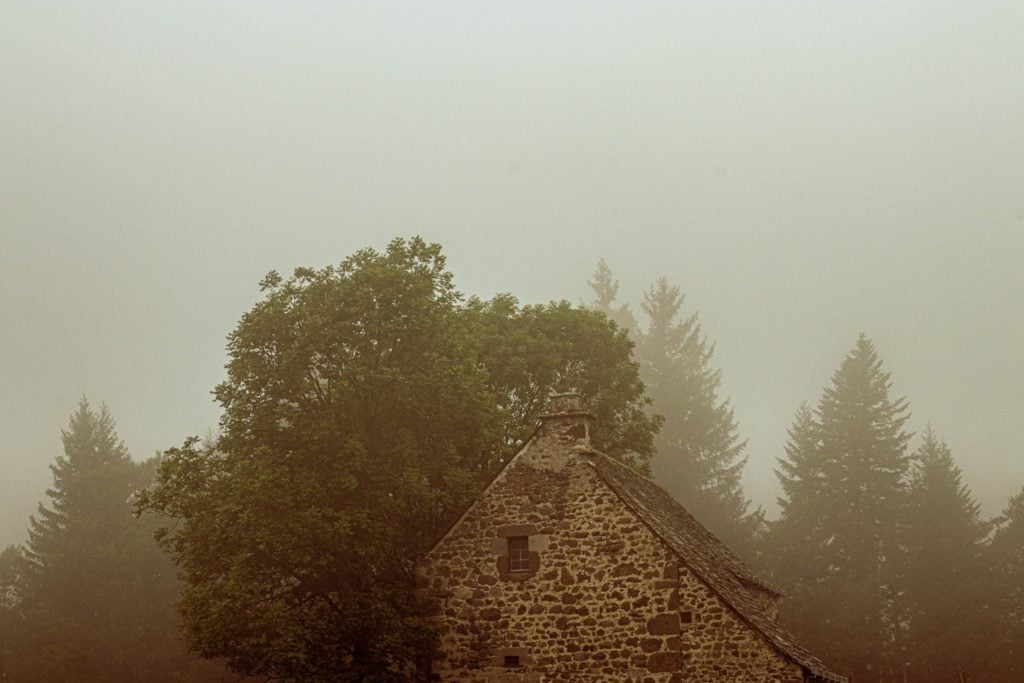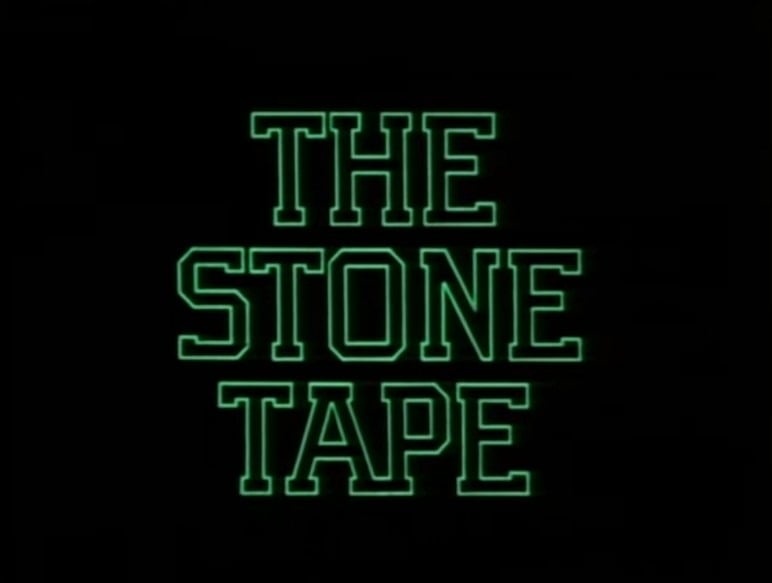Previously: Spirit Photography.
Here’s a term I hadn’t heard until fairly recently: The “stone tape theory.” “Huh,” I thought. “What’s the stone tape theory? How does it work? Is it new? Maybe I’m just woefully out of the loop. What gives?” It turns out that I’m not actually that far out of the loop; the more I read about the stone tape theory, the more I realized that it’s connected to a concept I’ve already been familiar with for some time: Residual hauntings.
But that realization, of course, brought up a whole new host of questions. Where did the term itself come from? Is there a difference between the stone tape theory and residual hauntings, or are they more or less the same thing? What’s the general consensus on it — both for those who believe in it and those who don’t?

So, naturally, I started to dig into a little more deeply. What I found was somewhat surprising; the source of the actual phrase, for example… wasn’t quite what I was expecting. So, even though this subject is a little different than the ones I usually focus on in these explorations of how certain forms of divination and ghost hunting techniques work, I figured it was worth a write-up. Seriously — if you’re not already aware of exactly why the stone tape theory is called the stone tape theory, you’re in for a treat.
Let’s get cracking, shall we?
A Brief History Of The Stone Tape Theory

As geoscientist and sham inquiry researcher Sharon Hill noted at the Skeptical Inquirer in 2018, it’s difficult to trace the history of the stone tape theory — largely because it hasn’t always gone by that particular name. Researchers and theorists have been writing about the ideas central to the theory for nearly 200 years, but it’s only within the past 50 years or so that the stone tape moniker arrived.
Most researchers point to mathematician Charles Babbage’s 1838 work The Ninth Bridgewater Treatise as one of the earliest, if not the earliest, mention of what would later come to be referred to as “place-memory” — the ability of a place to retain echoes of events that occurred there. In chapter nine, “On the permanent Impression of our Words and Actions on the Globe we inhabit” (which should give you an idea of what’s in store all on its own), Babbage wrote:
“The air itself is one vast library, on whose pages are for ever written all that man has ever said or women whispered. There, in their mutable but unerring characters, mixed with the earliest, as well as with the latest sighs of mortality, stand for ever recorded, vows unredeemed, promises unfulfilled, perpetuating in the united movements of each particle, the testimony of man’s changeful will.”
He did not mean this metaphorically.
When the Society for Psychical Research was founded in 1882, the concept of place-memory factored prominently in many of the organization’s early work and theories. In 1885, for example, Eleanor Sidgwick, physicist and eventual President of the Society for Psychical Research, described in an issue of the Journal of the Society for Psychical Research several possible explanations for what, exactly, a haunting might be — and when it came to houses or other structures, she posited that there could be “something in the actual building itself some subtle physical influence which produces in the brain that effect which, in its turn, becomes the cause of a hallucination.” (Fellow researcher and SPR founding member Frederic W. H. Myers later quoted Sidgwick’s piece at length in Human Personality and Its Survival of Bodily Death, first published in 1903.)
It’s worth noting that Sidgwick herself was unconvinced by this theory; she called it “one which I can hardly expect to appear plausible,” further noting, “I only introduce [it] because I think that it corresponds best to a certain part of the evidence.” But it does build somewhat on Babbage’s previous writing, making it another piece of the puzzle.
One of Sidgwick’s contemporaries, Edmund Gurney, further elaborated on the idea f place-memory, writing in the Journal of the Society for Psychical Research in 1888 that he believed certain apparitions to be not so much “hauntings” in the traditional sense, but rather “the survival of a mere image, impressed … by that person’s physical organism, and perceptible at times to those endowed with some cognate form of sensitiveness.” Gurney wasn’t sure exactly how this process of “impressing” worked — “we cannot guess how, or we cannot guess what,” he noted — but the idea was a compelling one all the same: It suggested that there might be a process by which a memory might be recorded on a place or object.
A number of other researchers and theorists continued to develop the idea of place-memory and residual hauntings as the decades passed, many of whom also came out of the Society for Psychical Research — including H. H. Price. Price’s 1939 work, Haunting and the Psychic Ether Hypothesis, posited that traces of memory might not only pin themselves to certain objects, but that the traces would reveal themselves to people with an aptitude for or sensitivity toward paranormal or supernatural forces. The traces, wrote Price, were “a result of the emotions or other experiences of some person who formerly inhabited the room, much as finger-prints result automatically from our handling of a wine-glass or a poker.” When people sensitive to the paranormal experienced the memories from these traces, they were essentially “playing back” the recording made by the “impressing” process posited by Gurney.
So where did the term “stone tape theory” come from? Not, as it’s sometimes suggested, from T. C. Lethbridge’s 1961 book Ghost and Ghoul. Lethbridge was heavily influenced by Price’s work and wrote at length about his belief that objects could store events that occurred near them with the help of certain energy fields — but nowhere does Lethbridge actually refer to tapes made of stone. The association between Lethbridge and the stone tape theory seems to come from a retroactive application of the term following, of all things, the broadcast of a specific teleplay on BBC 2 on Christmas Day in 1972: The Stone Tape, written by Nigel Kneale of Quatermass fame. The movie, which is available on YouTube if you want to watch it yourself, features a room built entirely of stone within a Victorian mansion slated for renovation — and which, it’s discovered, is haunted by a particularly gruesome memory: The death of a young woman within its walls more than 80 years prior.
The stone room, the characters surmise, is a kind of tape. The tape holds the recording of a young woman’s death. And to those who have a particular sensitivity, the room plays back the memory of the young woman’s final moments and over and over again.
Hence: The stone tape theory.
So: How is it all meant to work? Let’s take a look at both sides of the coin:
The Believer’s Argument

You’ll often hear the terms “residual haunting” and “stone tape theory” brought up alongside each other, or even in the same breath. But although they might seem interchangeable, there is a difference between the two concepts — or at least, there is the way I see it. I find it most helpful to think of residual hauntings as the actual paranormal phenomena, while the stone tape theory describes both the method by which the phenomena were created, and the mechanism by which sensitive observers experience them.
Hauntings — according to those who believe in them, in any event — come in a number of different flavors, so to speak. Intelligent hauntings involve a spirit or entity who is aware of and can consciously interact with humans and other living beings — think Marley’s ghost in A Christmas Carol. Poltergeist hauntings usually involve the entity interfering physically with objects or people, as in the case of the Enfield Poltergeist. (The word “poltergeist” itself is German for “noisy ghost.”) Demonic hauntings aim to “break down a person’s free will so that [the demon] can take over and possess the individual,” per the Psychic Library — e.g., what happened to “Robbie Manheim,” the pseudonymous case of demonic possession on which William Peter Blatty based the story of his 1971 novel The Exorcist and its subsequent big screen adaptation.
And then there are residual hauntings: Hauntings characterized not by the interactions between an entity and humans, but by a lack of interactions. The Psychic Library describes residual hauntings as “remnant[s] of past traumatic event[s] that happened at or near [a] location prior to someone’s death.” They might consist of sounds, smells, or scenes — but what they don’t do is change. If the haunting consists of an apparition of a woman appearing and climbing the stairs, it always manifests as an apparition of a woman appearing and climbing the stairs. It might appear only at a specific time of day, or on a specific date in the year, or when specific weather or celestial conditions are met. But no matter what triggers the apparition’s appearance, it won’t acknowledge anyone who might be watching it; indeed, it won’t even be aware that anyone is watching it in the first place. That’s because, unlike that of an intelligent haunting, the apparition of a residual haunting isn’t a sentient being — it’s an echo of the past. Watching a residual haunting is like watching a movie: The event the haunting depicts has already happened.
That’s where the stone tape theory comes in. The theory both supports the idea that residual hauntings are akin to pre-recorded movies or music and suggests the means by which they’re created and accessed.
The process described by the theory is meant to be analogous to magnetic tape recording. This variety of tape recording, which dates back to 1878, “works by converting electrical audio signals into magnetic energy, which imprints a record of the signal onto a moving tape covered in magnetic particles,” as music and recording website Reverb puts it. Recording film or video functions in much the same way. Playback, meanwhile, “is achieved by converting the recording on tape back into electrical energy to be amplified,” per Reverb — e.g., what happens when you take the tape onto which you recorded your data, pop it into a tape player, and hit the “play” button.
According to the stone tape theory, the energy generated by traumatic, emotional, or tragic events imprints records of those events on nearby physical objects — typically stone, ideally quartz or limestone — in much the same way that magnetic tape recording imprints data on strips of magnetic tape. The traumatic event is equivalent to the electrical audio signals in magnetic tape recording; the energy of the event is the magnetic energy into which the electrical audio signals have been converted; and the stone is the magnetic tape itself. Playback of the stone “tape” occurs not when you put the “tape” in a literal player and press a button, but either when certain circumstances are met — often circumstances that match up with the ones that were present when the “recording” was made — or simply when someone who’s sensitive to the energy comes in contact with the “tape.” Put in another way, the “tape player” can be either the environment or certain people.
Many of the world’s most infamous hauntings are of the residual variety. The story of Anne Boleyn’s ghost riding up to Blickling Hall in a phantom carriage and wandering around the grounds all night, head in hands, on the anniversary of her death each year? That’s a residual haunting. The reports of sightings at the building in New York at which the Triangle Shirtwaist Factory fire occurred in 1911? Also residual hauntings. Many of the ghosts at the Roosevelt Hotel? Residual. Indeed, many people believe that residual hauntings are the most common types of hauntings, although there’s a lack of measurable statistics on the subject.
The stone tape theory is an idea only, unproven and purely conjectural. But odds are that if you believe in hauntings, you believe in the stone tape theory, even if you don’t know it by that name.
The Skeptic’s Argument

The skeptic’s argument is much briefer than the believer’s argument: How does the stone tape theory work? It doesn’t. The simple, indisputable truth is that there is no method, procedure, apparatus, or gadget in existence which is capable of recording the data involved in a residual haunting on stone, let alone recording it on said stone in a form which can be replayed over and over again like a home video or your favorite song.
Furthermore, there’s an issue with the data itself: Whereas magnetic tape recording imprints objective data onto the tape in question, the “data” referred to in the stone tape theory is subjective. It relies on emotion, and emotion doesn’t actually create anything you can capture in any measurable form.
So, although you can use a stone to hold data in that you could, say, etch a picture, words, symbols, or numbers on it, you can’t use it in the way that the stone tape theory proposes. The natural world just… doesn’t work that way. As Theodore Schick and Lewis Vaughn put it in their book How To Think About Weird Things: Critical Thinking For The New Age, “Chunks of stone just do not have the same properties as reels of tape.” I’d go a step further and say that emotions don’t have the same properties as sound, or electrical audio signals, or magnetic energy, either. It fails on both fronts.
Also, Sharon Hill rightly points out at the Skeptical Inquirer that the stone tape theory… isn’t actually a theory. Or at least, it isn’t in the scientific sense — but since it often tries to couch itself in scientific terminology, that means it’s pseudoscience at best.
As biology professor Jaime Tanner of Marlboro College explained to LiveScience in 2017, “The way that scientists use the word ‘theory’ is a little different than how it is commonly used in the lay public. Most people use the word ‘theory’ to mean an idea or hunch that someone has, but in science, the word ‘theory’ refers to the way we interpret facts.” Indeed, facts are necessary for a theory to exist — but there are no actual facts about the stone tape theory. For example, Hill notes, we don’t know the answers to any of the following questions about it:
“How do things get recorded?
What gets recorded and what doesn’t?
How is it preserved?
How can it be played back?”
Because we have no facts pertaining to the stone tape theory, we can’t interpret them or put them into a framework — that is, we can’t do what’s actually necessary to form a scientific theory. All we can do is speculate — and speculation is not theorization.
What Do You Believe?

There’s a lot of back and forth about the stone tape theory between believers and skeptics — a push and pull which ultimately arrives at no conclusions.
Many believers, for example, do acknowledge that we don’t know the exact process by which a stone tape might be created; the position is that we just haven’t figured it out yet. Skeptics, meanwhile, consider that position to be a logical fallacy: It assumes the existence of properties we’ve never before observed in stones, yet also have no reason to believe we’ll ever observe in stones.
Some believers also find it problematic that, for all the detail with which they can debunk certain phenomena, skeptics often are “unable to explain with equal thoroughness just why so many people do see spectres/ghosts in the same places as others had seen them,” as one Redditor put it: “The fact so many people (many of whom previously did not believe in the existence of ghosts yet saw the same ghost, same place as seen by others) is the reason the stone tape theory was devised,” they noted. Meanwhile, skeptics point out that frequently, there’s no way to verify that all of those people who report seeing a ghost at a specific place are seeing the same ghost (or “ghost,” as the case may be).
I’m not sure how useful the back-and-forth is. Usually, those who believe, believe; those who don’t believe, don’t; and neither will ever be convinced otherwise. And round and round and round we go.
Me? As I’ve noted a number of times, I don’t really believe in hauntings, residual or otherwise, in and of themselves. I’ll tell you what I do believe in, though: I believe in history. I believe in emotions. And I believe in the ability of our own emotions, both surrounding events that occurred at specific locations and those which exist independently, to influence how we experience those places.
Belief is a powerful thing.
And sometimes, that’s all the explanation we need.
[Photos via Eric Muller/Unsplash; Marsupium Photography, Guilhem Vellut/Flickr, available under CC BY-SA 2.0 and CC BY 2.0 Creative Commons licenses; Wikimedia Commons, available under the public domain.]